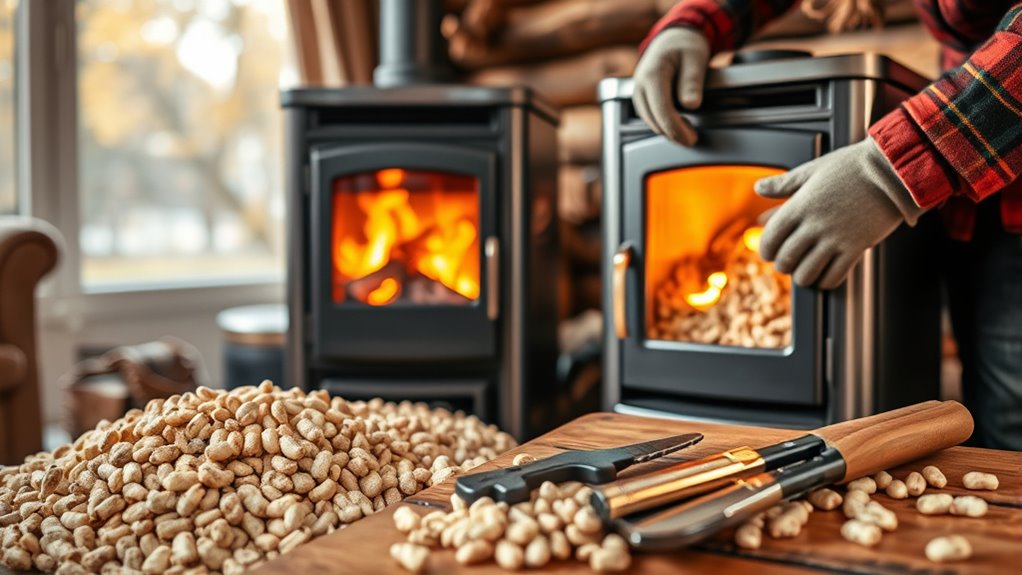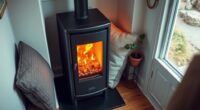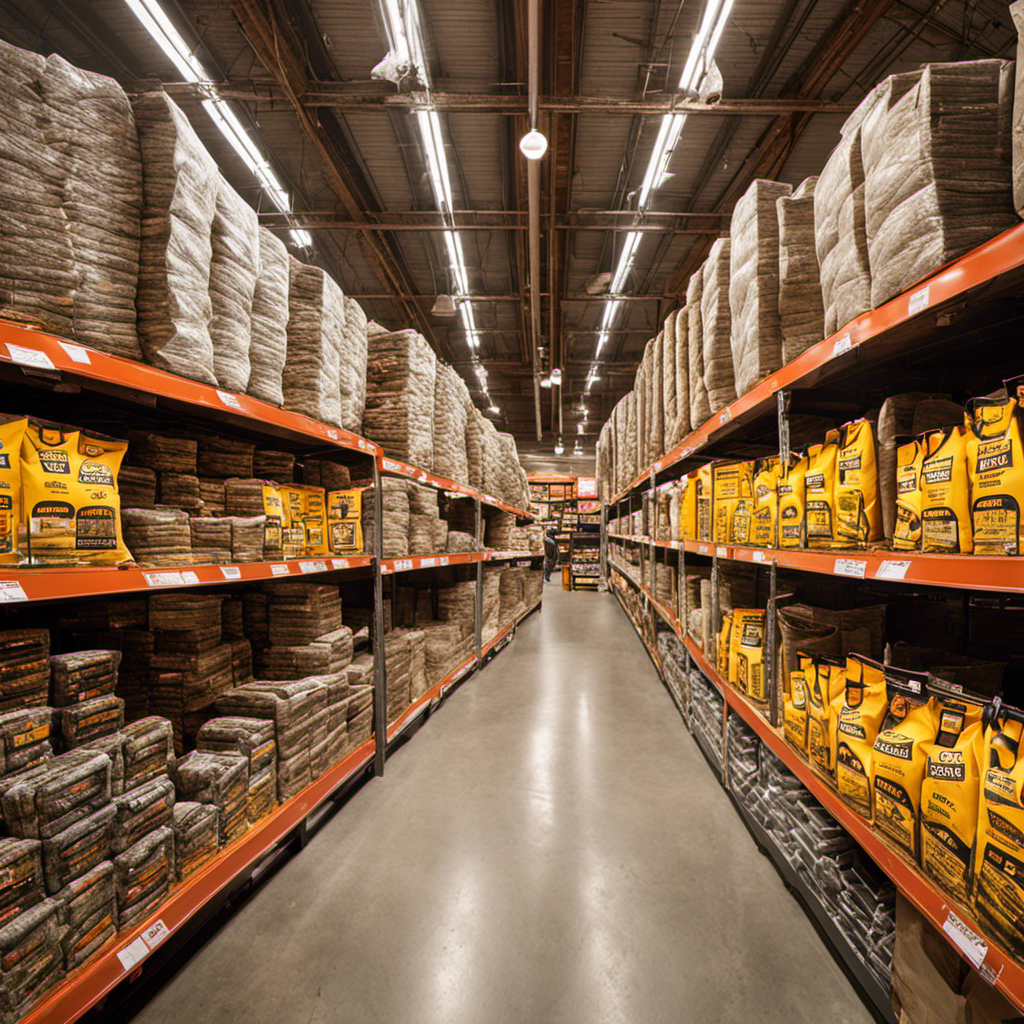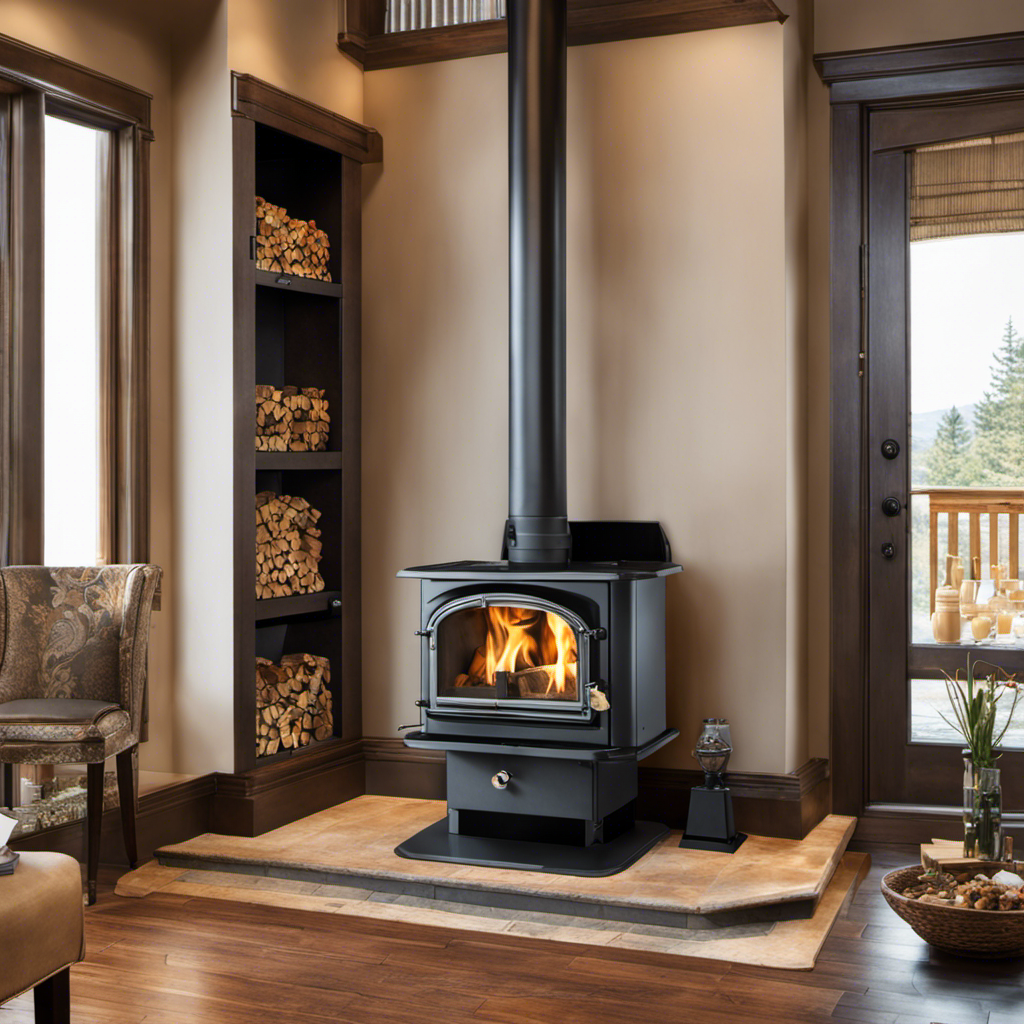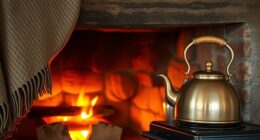To maintain your pellet stove effectively, you should perform seasonal cleaning, such as inspecting and cleaning the heat exchanger, ash removal, and checking gaskets before winter. During the heating season, clean weekly and address any buildup, while deeper cleaning is necessary at the end of winter or spring shutdown. Using the right tools and quality pellets helps reduce wear. Regular professional checks keep your stove running smoothly—continue exploring for detailed tips to extend your stove’s lifespan.
Key Takeaways
- Perform regular cleaning and ash removal during heating season to ensure efficient and safe stove operation.
- Conduct thorough fall and spring deep cleaning, including vent and heat exchanger inspection, to prevent creosote buildup and rust.
- Use high-quality, low-ash pellets to minimize soot, creosote, and maintenance frequency.
- Schedule professional inspections annually after burning 1-2 tons of pellets or if issues arise.
- Maintain door seals, gaskets, and internal components to extend stove lifespan and ensure optimal performance.
Why Regular Pellet Stove Maintenance Is Essential
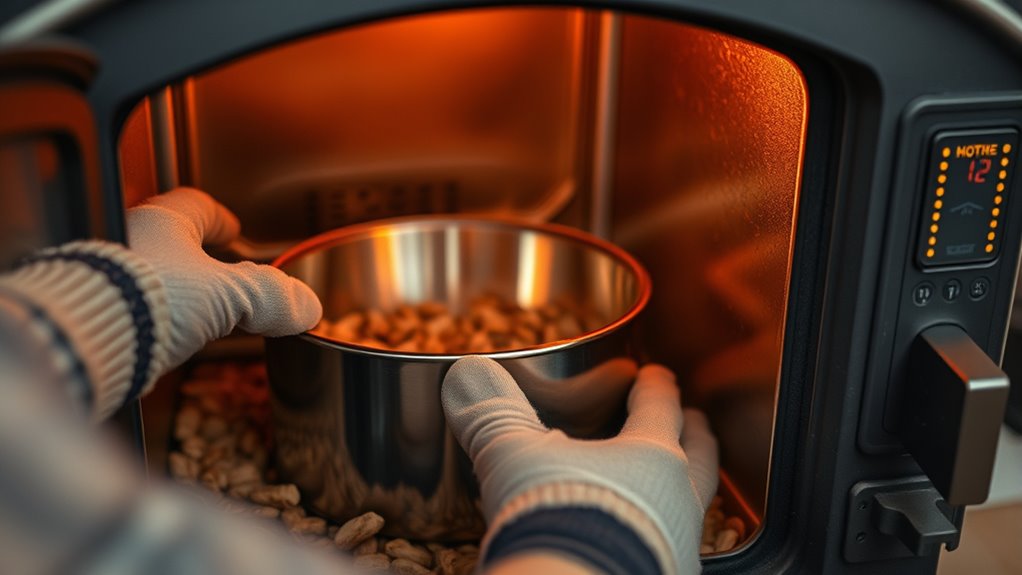
Regular pellet stove maintenance is crucial because it keeps your stove functioning safely and efficiently. Without regular upkeep, ash buildup can block airflow and reduce combustion efficiency, making your stove work harder. Cleaning out ash and soot prevents vent blockages and reduces the risk of creosote buildup, which can cause dangerous chimney fires. Routine maintenance also minimizes wear on stove parts, helping your pellet stove last longer. When you stay on top of cleaning and inspections, you catch potential issues early, avoiding costly repairs and safety hazards. Proper maintenance ensures your stove transfers heat effectively, which lowers fuel consumption and reduces operating costs. Additionally, understanding the importance of local laws can help you stay compliant with safety regulations and avoid penalties. Knowing how technology impacts your stove’s performance can help you choose the right maintenance practices. Staying informed about industry standards can also guide you in maintaining optimal operation and safety compliance. Regular inspections of the venting system are essential to prevent blockages and ensure proper draft. Incorporating preventive maintenance practices can further extend your stove’s lifespan and improve its efficiency.
Key Tasks for Fall Cleaning and Preparation
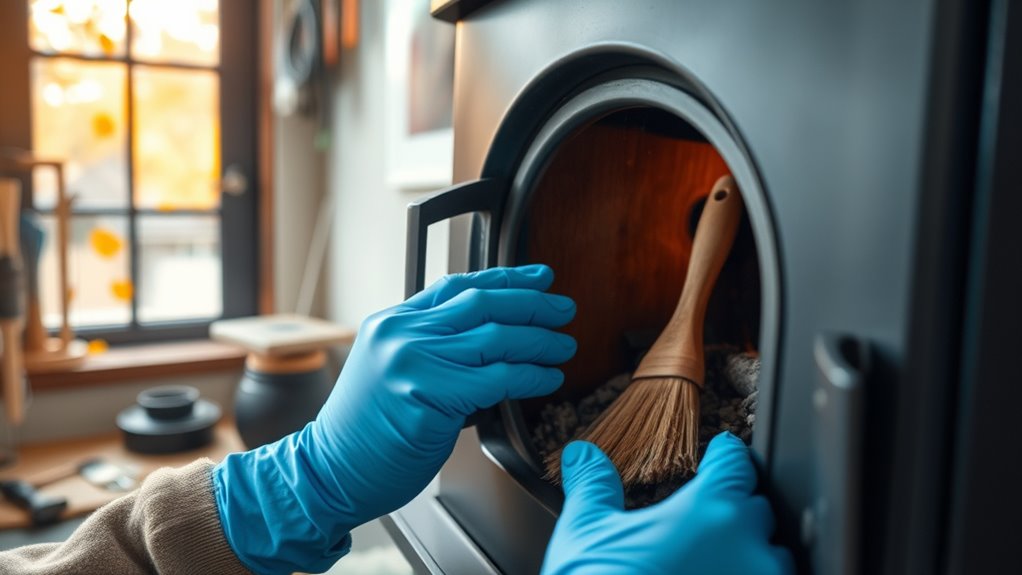
As the heating season approaches, it’s vital to perform fall cleaning and preparation to guarantee your pellet stove runs safely and efficiently all winter long. Start by inspecting the heat exchanger rods and venting system, removing any soot or creosote buildup to prevent blockages and ensure proper airflow. Next, clean the glass door with an ammonia-free cleaner for a clear view and better monitoring. Remove ash and carbon deposits from the burn pot to promote efficient combustion and consistent heat output. Check the door and hopper lid gaskets for signs of wear or leaks, replacing them if necessary to maintain a proper seal. Proper stove maintenance also includes inspecting the venting system periodically to prevent potential dangerous blockages and ensure safe operation throughout the winter. Additionally, regular inspections of the electrical connections help prevent potential malfunctions. Ensuring your payment processing systems are up-to-date can also streamline service scheduling and parts ordering during peak season. Finally, clear out any remaining pellets from the hopper and firebox to prevent moisture absorption and rust. Proper fall prep keeps your stove in top shape during the cold months. Being aware of proper maintenance techniques, such as understanding toilet maintenance and repairs, can also help you troubleshoot issues that may arise during the season.
Weekly Upkeep During the Heating Season
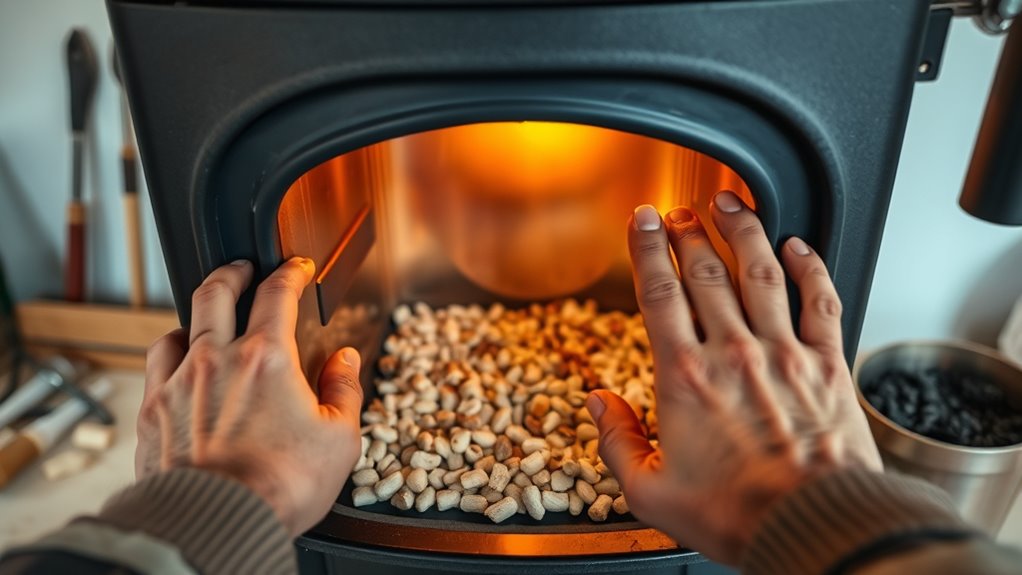
To keep your pellet stove running efficiently and safely throughout the heating season, it is essential to perform weekly maintenance tasks. Start by using an ash vacuum to remove ash from the burn box and ash pan, guaranteeing proper airflow and combustion. Regular stove cleaning includes scraping the burn pot with a flathead screwdriver or scraper to eliminate carbon buildup. Don’t forget to vacuum the heat exchangers and interior passages to prevent soot buildup, which can reduce efficiency. Wipe the glass with an ammonia-free cleaner and a soft cloth to maintain clarity and prevent soot accumulation. Additionally, check and clean the glass gasket and door seals weekly to ensure airtight operation and prevent smoke leaks. Proper placement of your stove can also improve airflow and overall performance. It is also beneficial to consult your stove’s manual or a professional for maintenance tips that prolong the life of your appliance. Regularly inspecting the airflow system helps prevent blockages that can hinder efficiency. Performing these routine checks and maintenance tasks is vital for fire safety and to avoid potential hazards. Moreover, keeping a maintenance schedule can help you stay on top of necessary upkeep. Consistent upkeep keeps your stove operating smoothly all season long.
Deep Cleaning Procedures for Spring Shutdown

Spring shutdown is the perfect time to give your stove a thorough cleaning. You should scrub the heat exchanger rods and fins with a wire brush to remove soot, and vacuum out all ash from the firebox and ash pan. Don’t forget to clean the venting system and wipe down the glass door to keep your stove in top shape for next season. Additionally, inspecting and cleaning the air purification components can help ensure optimal performance when you start using your stove again. Regular maintenance of these components can also reduce harmful pollutants emitted during operation, contributing to a healthier environment. Checking the waterpark area for any buildup or debris can prevent potential issues and improve overall efficiency. Ensuring proper performance tuning can further enhance your stove’s longevity and efficiency over time.
Cleaning Heat Exchanger Components
During spring shutdown, it’s essential to thoroughly clean the heat exchanger components to guarantee your pellet stove operates efficiently next season. Start by removing the heat exchange rods and fins, inspecting them for ash buildup and soot. Use cleaning tools like a wire brush to scrub the surfaces, ensuring stubborn deposits are fully removed without damaging delicate fins. Check the passages within the heat exchanger for obstructions or soot blockages, clearing them to maintain proper airflow. After cleaning, inspect the rods for signs of corrosion or damage, replacing any compromised parts to prevent future performance issues. Reassemble all components securely, making sure all connections are tight and debris-free. Proper cleaning of the heat exchanger improves heat transfer and helps your stove run smoothly throughout the heating season. Additionally, maintaining a clean heat exchanger can prevent ineffective purification and ensure optimal operation of your pellet stove. Regular inspection and cleaning can also help identify potential issues early, saving you time and money in the long run. Incorporating preventive maintenance practices, such as checking the stove’s filtration system, can further extend the lifespan of your stove components and maintain peak performance. Staying informed about AI-driven diagnostics can assist in early detection of operational problems, optimizing your stove’s efficiency.
Removing Residual Ash and Debris
Before starting your deep cleaning, make sure the stove is completely cool and unplugged to avoid electrical hazards. Remove all remaining pellets from the hopper and firebox to prevent moisture absorption and corrosion during storage. Use a high-powered ash vacuum to thoroughly clean out ash, soot, and debris from the firebox, heat exchanger, and venting system. Scrape and clean the burn pot, heat exchanger fins, and interior surfaces with appropriate tools to remove carbon buildup and soot. Pay special attention to venting pipes and the chimney, inspecting and cleaning them to eliminate creosote and blockages. Removing residual ash and debris ensures proper airflow, improves efficiency, and prepares your pellet stove for safe, maximum operation during the next heating season. Regular cleaning also helps prevent clogged filters and maintains optimal performance.
Choosing the Right Tools for Effective Cleaning
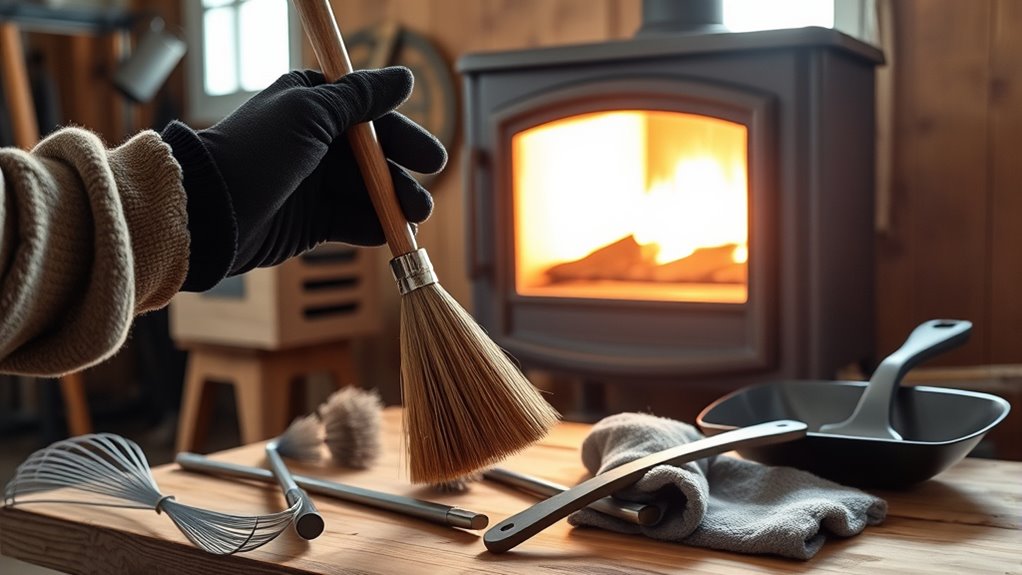
Choosing the right tools is essential for effectively cleaning your pellet stove and maintaining its performance. Start with a chimney brush kit that has durable rods and heat-resistant bristle heads, designed specifically for pellet stove vent cleaning to remove soot and creosote buildup. For detailed cleaning of heat exchanger fins and burn pot components, select Rutland pellet stove brushes in 3- or 4-inch sizes. Use a high-quality ash vacuum, like the PowerSmith™ model, to safely and efficiently remove ash from the firebox and surrounding areas without creating dust. Keep soft, ammonia-free cleaners such as Sprayway or Rutland on hand to clean glass surfaces without scratching thermal coatings. Additionally, flathead screwdrivers or scrapers are useful for carefully removing carbon deposits from the burn pot and hard-to-reach parts.
The Impact of Pellet Quality on Cleaning Frequency
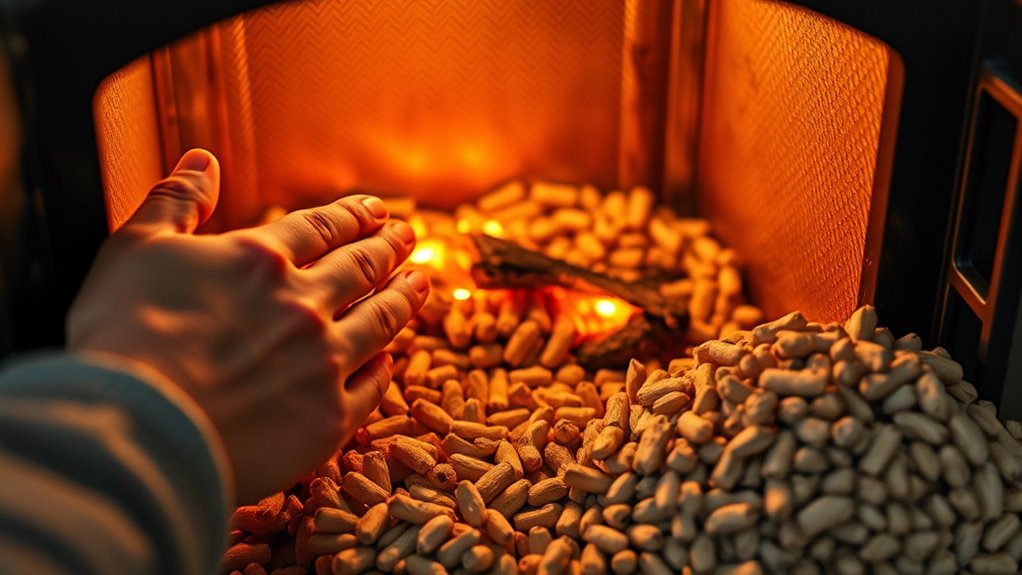
The quality of your pellets directly affects how often you’ll need to clean your stove. Using high-quality pellets with low ash content means less buildup and fewer maintenance sessions. Conversely, low-grade pellets produce more soot and ash, requiring more frequent cleaning to keep your stove running efficiently.
High-Quality Pellets Reduce Ash
Using high-quality pellets with low ash content directly reduces the amount of residual ash left after burning, which means you’ll need to clean your stove less often. Premium pellets made from clean, processed materials produce minimal soot and creosote buildup, extending intervals between stove maintenance. This reduces clogging of the burn pot and heat exchanger, saving you time and effort. The table below highlights the benefits:
| Benefit | Effect |
|---|---|
| Less residual ash | Less frequent cleaning |
| Reduced soot and creosote | Fewer maintenance sessions |
| Minimized clinker formation | Better stove performance |
| Lower clogging risk | Easier stove operation |
| Increased efficiency | Longer lifespan of your pellet stove |
Low-Quality Pellets Increase Soot
Low-quality pellets produce more ash and soot during combustion, which means you’ll need to clean your stove more often. The increased soot can build up quickly, requiring frequent stove cleaning to prevent blockages and maintain efficiency. These pellets often contain extra dust and crumbling pieces that lead to more soot, clogging your burn pot and heat exchanger faster. The higher ash content from low-quality pellets accelerates creosote buildup in the venting system, raising fire risks. Over time, this excess ash and soot put stress on your stove, reducing its lifespan. To keep your pellet stove running smoothly and safely, avoid low-quality pellets that create more ash and soot. Regular cleaning helps manage the buildup caused by inferior pellets, ensuring ideal performance.
Pellet Purity Extends Maintenance
Choosing high-quality pellets with low ash content can substantially reduce the amount of residue left inside your stove and venting system. Pellet purity directly impacts ash content, which determines how often you’ll need to clean. High-grade pellets burn cleaner, producing less soot and creosote buildup, ultimately decreasing cleaning frequency. Conversely, low-grade pellets with excessive dust and crumbling increase ash production, leading to more frequent maintenance. Burning premium pellets minimizes residual buildup, helping your stove operate efficiently and safely for longer periods. When you select consistent, high-quality pellets, you extend the intervals between deep cleanings and protect your stove’s lifespan. Prioritizing pellet purity ensures you enjoy a cleaner, more efficient heating experience with less hassle.
Recognizing When Professional Service Is Needed
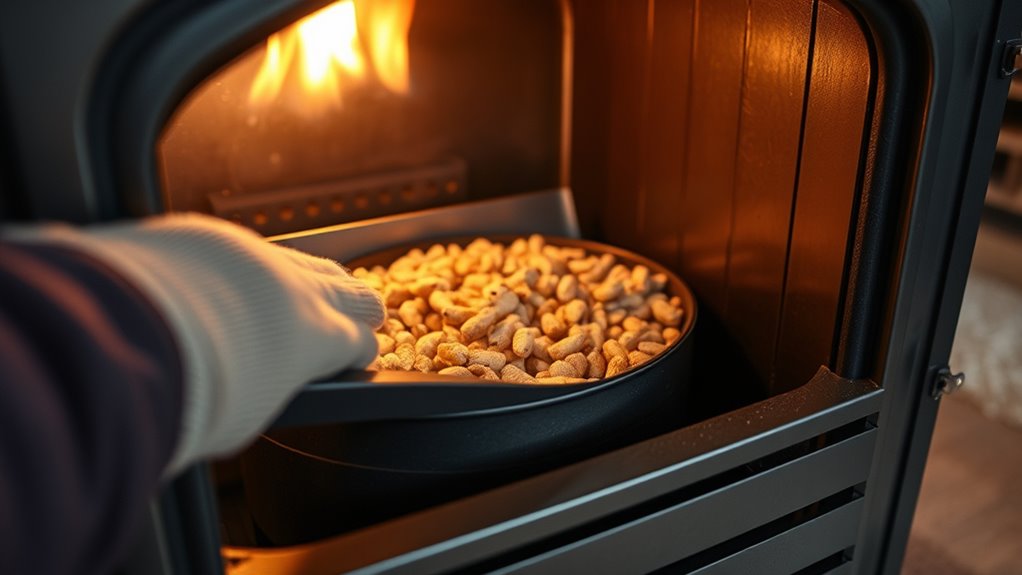
Recognizing when your pellet stove needs professional service is essential for maintaining safe and efficient operation. If you’ve burned one or two tons of pellets or notice performance issues, it’s time to schedule a professional pellet stove maintenance appointment. Signs like persistent smoke, difficulty igniting, or uneven heating indicate that an inspection by a licensed technician is necessary. They can identify worn parts such as sensors, gaskets, or blowers and replace them to restore top-notch function. Routine professional cleaning during the off-season also prevents rust, creosote buildup, and vent blockages that could compromise safety. Additionally, if error codes appear, or you smell strange odors or hear unusual noises, don’t delay—professional service ensures your stove operates safely and efficiently.
Tips for Extending Your Stove’s Lifespan

To maximize your pellet stove’s lifespan, regular maintenance is key. Consistently performing stove maintenance, including regular cleaning and ash removal, prevents buildup that can cause wear and decrease durability. Using high-quality pellets with low ash content helps reduce soot and residue, lessening maintenance needs and extending your stove’s lifespan. Scheduling annual professional maintenance detects worn parts early, avoiding costly repairs. Additionally, keep the stove’s interior dry and free of moisture-laden pellets to prevent rust and corrosion. Follow manufacturer guidelines closely to ensure exemplary performance. To visualize key maintenance tips:
| Tip | Why it matters | How to do it |
|---|---|---|
| Regular cleaning | Prevents buildup of ash | Clean burn pot and heat exchanger regularly |
| Ash removal | Stops clogging and corrosion | Remove ash after every use |
| Use quality pellets | Minimizes residue and soot | Choose low-ash, high-quality pellets |
Scheduling and Planning Your Seasonal Maintenance

Planning your pellet stove maintenance around key seasonal milestones keeps it running smoothly. Scheduling cleaning at the end of the heating season or during summer helps prevent rust and makes sure it’s ready when cold weather hits. By booking professional service early, you avoid fall rushes and extend your stove’s lifespan.
Optimal Cleaning Timelines
Scheduling your pellet stove’s seasonal maintenance early in the year helps guarantee it’s ready before the cold weather hits. Establishing a cleaning schedule ensures your stove stays efficient and lasts longer. Here’s what to keep in mind:
- Perform routine weekly or bi-weekly cleanings to reduce buildup and maintain stove efficiency.
- Plan your annual cleaning after burning one to two tons of pellets, focusing on deep cleaning for peak performance.
- Book professional seasonal maintenance during the off-season, ideally at the end of winter, to prevent rust and corrosion.
- Schedule your annual cleaning early in the season to avoid fall rushes and ensure your stove is prepared for the cold months ahead. Staying proactive keeps your pellet stove running smoothly year-round.
Off-Season Service Benefits
Performing off-season maintenance on your pellet stove offers numerous benefits, including extending its lifespan and ensuring reliable performance year after year. Scheduling an off-season service allows you to thoroughly clean and inspect your stove’s components like blowers, sensors, and venting without disrupting your heating schedule. Regular maintenance during the off-season helps prevent rust and corrosion, which can cause costly damage over time. Booking service at the end of the heating season means your stove will be ready for efficient operation when temperatures drop again. Additionally, planning your cleaning and maintenance during quieter months reduces the risk of unexpected breakdowns during peak use. Off-season service often costs less and provides more flexible appointment options, making it easier to keep your pellet stove in top condition.
Safety Measures and Best Practices for Cleaning

Before you start cleaning your pellet stove, always turn it off and unplug it to prevent electrical shocks and accidental ignition. Safety is vital during maintenance, so follow these best practices:
- Wear fire-resistant gloves and protective eyewear to avoid burns from hot surfaces and debris.
- Use only manufacturer-recommended cleaning tools and solutions to prevent damage.
- Keep the area clear of flammable objects and debris to reduce fire risks.
- Ensure proper ventilation when cleaning to avoid inhaling dust, ash, or fumes, and follow guidelines for ash disposal safely.
These steps help maintain safety during cleaning, protect your stove’s components, and keep your home secure. Regular maintenance with proper safety measures reduces hazards and prolongs your pellet stove’s lifespan.
Frequently Asked Questions
What Maintenance Does a Pellet Stove Require?
You need to regularly clean the burn pot, ash pan, and glass to keep your pellet stove running efficiently. Weekly, remove ash, vacuum interior passages, and check door seals. Annually, clean the heat exchanger, venting system, and inspect electrical parts. Using quality pellets helps reduce ash buildup. Schedule a professional inspection yearly to verify sensors, blowers, and vents stay in top shape, preventing costly repairs.
Why Are People Getting Rid of Pellet Stoves?
So, you’re wondering why folks are ditching their pellet stoves? Well, turns out, those charming little heaters come with a hefty price tag—constant cleaning, repairs, and skyrocketing pellet costs. Plus, environmental worries and new tech alternatives make sticking with them feel like clinging to a dinosaur. Safety concerns about venting and fire hazards also play a part. Basically, people are upgrading to smarter, cleaner, and more economical heating options.
Should I Unplug My Pellet Stove During the Summer?
You should unplug your pellet stove during the summer to prevent electrical issues and save energy when it’s not in use. Unplugging allows you to clean and inspect the internal parts thoroughly, reducing rust and corrosion. It also minimizes the risk of accidental startup or electrical shorts. Make sure to follow your manufacturer’s instructions for proper unplugging and storage, ensuring your stove stays safe and in good condition during the off-season.
How Do You Prepare a Pellet Stove for Winter?
Think back to those days when you’d prepare your gear for winter, and now it’s time to do the same for your pellet stove. You should thoroughly clean the stove, including the heat exchanger, burn pot, and interior passages, to remove ash and soot. Inspect the venting system for blockages, replace door and hopper lid gaskets, and empty the ash pan. A professional check-up can guarantee everything runs smoothly all season long.
Conclusion
Regular maintenance keeps your pellet stove running smoothly and safely all year round. Imagine neglecting a simple fall cleaning, only to find your stove jammed during a cold snap. By sticking to a seasonal schedule, using the right tools, and knowing when to call in pros, you extend its lifespan and avoid costly repairs. Take control now—your cozy, trouble-free winter depends on it. Keep up with maintenance, and enjoy warm, worry-free comfort season after season.

